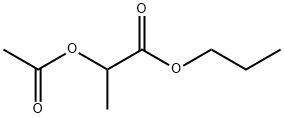
N-PROPYL ACRYLATE synthesis
- Product Name:N-PROPYL ACRYLATE
- CAS Number:925-60-0
- Molecular formula:C6H10O2
- Molecular Weight:114.14

71-23-8
749 suppliers
$12.00/100g

79-10-7
687 suppliers
$20.16/100 mL

925-60-0
56 suppliers
$62.00/10g
Yield:925-60-0 98%
Reaction Conditions:
with toluene-4-sulfonic acid at 60; for 24 h;Neat (no solvent);
Steps:
4.1.2. Synthesis of propyl acrylate 27
The reaction was carried out using 1.0 mmol of acrylic acid 25, 3.0 mmols of propyl alcohol 26 and 0.1 Equiv. p-Toluenesulfonic acid (PTSA) under heating at 60 °C for 1 day. The reaction was allowed to reach room temperature, diluted with CH2Cl2 (15 mL) and washed with a cold solution of 10% NaOH (2 × 8 mL) and then with a cold solution of saturated NaCl (1 × 8 mL). The organic phase was dried with MgSO4, filtered and distilled at 70 °C, 98% yield; colorless oil; 1H NMR (CDCl3, 200 MHz) δ: 0.96 (t, 4H, J = 7.4 Hz); 1.69 (sex, 3H); 4.11 (t, 2H, J = 6.6 Hz); 5.81 (dd, 1H, J = 10,4/1.8 Hz); 6.12 (dd, 1H, J = 17.4/10.4 Hz); 6.40 (dd, 1H, J = 17.4/1.8 Hz). 13C NMR (CDCl3, 50 MHz) δ: 10.39, 21.96, 66.12, 128.59, 130.48, 166.36.
References:
Silva, Fabio P.L.;De Assis, Priscilla A.C.;Junior, Claudio G.L.;De Andrade, Natalia G.;Da Cunha, Saraghina M.D.;Oliveira, Marcia R.;Vasconcellos, Mario L.A.A. [European Journal of Medicinal Chemistry,2011,vol. 46,# 9,p. 4295 - 4301] Location in patent:experimental part

71-23-8
749 suppliers
$12.00/100g
201230-82-2
1 suppliers
inquiry

74-86-2
71 suppliers
inquiry

925-60-0
56 suppliers
$62.00/10g

71-23-8
749 suppliers
$12.00/100g

814-68-6
377 suppliers
$21.21/5gm:

925-60-0
56 suppliers
$62.00/10g

20473-73-8
0 suppliers
inquiry

925-60-0
56 suppliers
$62.00/10g
